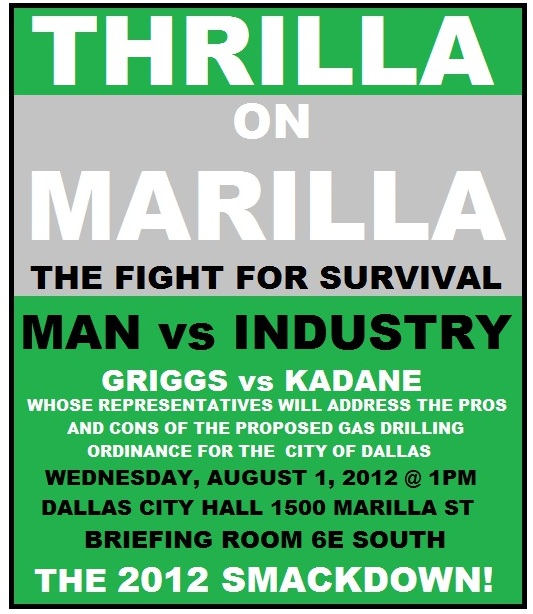Archive for July 2012
Reminder
The Cumulative Impacts Project
 A major flaw in the official government risk assessment process that guides the awarding of new air pollution permits is the lack of accounting for the "cumulative impacts" and interactions in the human body of of multiple sources of pollution and the multiple chemicals in that pollution.
A major flaw in the official government risk assessment process that guides the awarding of new air pollution permits is the lack of accounting for the "cumulative impacts" and interactions in the human body of of multiple sources of pollution and the multiple chemicals in that pollution.
To take the example form the previous post – EPA and TCEQ will not consider whether garbage burning and the phthalate emissions it might cause will impose additional risks for diabetes on a typical Latino woman who's already exposed to a lot of phthalates, and already has a higher risk of diabetes than her white peers. Those agencies don't consider her background exposure to this class of chemicals, or her greater propensity to contract the disease.
Nor do they think how the phthalates interact with the benzene, or the toluene, or the dioxins, or the ozone, or anything else that's not mentioned in the very specific permit request a facility is seeking. With 80,00 chemicals on the market, and only a couple of dozen thoroughly studied for their possible health effects, we're all lab rats.
Now there's an organization and a website that's taking on this short-sighted approach to pollution control. It's called the Cumulative Impacts Project. It was founded by the Science and Environmental Health Network (SEHN) and the Collaborative on Health and the Environment (CHE).
According to its website,
"The primary goal of the Cumulative Impacts Project is to collect the latest science, emerging best practices, analytical tools, and legal shifts that can reduce cumulative harm to our planet, our communities, and ourselves."
Check it out.
Groups Sue Over Fracking Causing Rural Utah Smog Problem
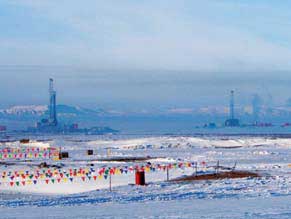 Last week five groups, including Utah Physicians for a Healthy Environment, EarthJustice, and the Southern Utah Wilderness Alliance sued the EPA for not classifying the Uintah Basin as a "non-attainment area" for the new federal ozone standard despite having plenty of evidence that the gas mining region is routinely experiencing some of the worst smog in the country.
Last week five groups, including Utah Physicians for a Healthy Environment, EarthJustice, and the Southern Utah Wilderness Alliance sued the EPA for not classifying the Uintah Basin as a "non-attainment area" for the new federal ozone standard despite having plenty of evidence that the gas mining region is routinely experiencing some of the worst smog in the country.
"It was once considered strictly a summertime problem in big cities. But winter pollution readings from the oil and gas fields of Wyoming and eastern Utah in the past seven years have shown the pollutants that create ozone— nitrogen oxides and volatile organic compounds — can also cause problems in snowy, rural areas.
Monitoring data in the Uintah Basin collected between 2009 and 2011 shows violations of federal health limits on ground-level ozone, which are set at 75 parts per billion. In 2010 and 2011, ozone levels rose as high as 121 parts per billion and 139 parts per billion, respectively."
To most of us this would mean the area is indeed due a non-attainment designation and should be required to draw up a plan to bring smog levels down. But to EPA, this only means the area is "unclassifiable," and it can put off that planning. That's why the groups are suing. And that's why it doesn't pay to think the EPA is taking care of everything.
But think about how this situation tests the claims of the gas industry operators.
In a previously pristine environment, without any cars or other kinds of heavy industry, they've now created smog on par with Los Angeles and Houston in the middle of extremely rural Utah…in the wintertime! They say they don't need new regulations; that they can voluntarily apply pollution controls. But in Utah, they either haven't done so in sufficient numbers, or those controls are clearly inadequate. Something more is needed than just voluntary controls.
Something like off-sets that require you to reduce as much air pollution as you spew.
Exposure to Phthalates (Plastics) Linked to Diabetes in Women
 Just last week we mentioned that one of the chemicals to look out for in burning plastics was phthalates – a class of widely-used chemicals that make plastic more plastic, i.e. more flexible. Phthalates are used in perfumes, cosmetics, and lots of household items made with Polyvinyl Chloride. This is how the stuff ends up in garbage, and how it can end up in your lungs when that garbage is burned at a cement kiln or power plant as "fuel" in the name of "recycling."
Just last week we mentioned that one of the chemicals to look out for in burning plastics was phthalates – a class of widely-used chemicals that make plastic more plastic, i.e. more flexible. Phthalates are used in perfumes, cosmetics, and lots of household items made with Polyvinyl Chloride. This is how the stuff ends up in garbage, and how it can end up in your lungs when that garbage is burned at a cement kiln or power plant as "fuel" in the name of "recycling."
This isn't a theoretical problem. When Midlothian area residents began collecting their own air samples downwind of the local hazardous-waste burning cement plants in the 1990's, they often found significant levels of phthalates.
From past research we know that exposure to phthalates in the womb can disrupt male hormones and have a range of health effects including feminizing male genitalia and reduced IQ.
And guess what? Ellis County rates of Hypospadias (a congenital birth defect in which the opening of the urethra is on the underside, rather than at the end, of the penis. are almost twice as high as for the state a a whole.
This week comes the news that Harvard scientists have linked phthalates to diabetes among women, and particularly to women of color in the Latino and Black communities who experienced the most exposure. Among these populations the risk of diabetes was double. The researchers cautioned that they don't yet know if phthalates actually cause the disease, but they seemed sure of an association.
“It’s extremely likely that phthalates and other chemical contaminants will turn out to be a big part of the obesity and diabetes epidemic, but at this point we really don't know how these chemicals are interacting with each other, or with the human body.”
Diabetes, an endocrine disease marked by problems with insulin production or insulin resistance, affects nearly 26 million Americans, or 11 percent of the population older than 20, according to CDC data. People of color already suffer disproportionally from the disease. According to the Centers for Disease Control, blacks have a diabetes rate 77 percent higher than that of whites, while Latinos have a 66 percent higher rate.
The Harvard study is at least the third in in two years to link phthalates to diabetes in women or adults in general.
“With phthalates, the story is really still emerging,” said Kristina Thayer, a researcher with the National Institute of Environmental Health Sciences and the National Toxicology Program. “Studies like these are considered exploratory, but they seem to be consistent.” “More needs to be done to really fill in this question of potential causality, and the roles that specific phthalates may play,” she added.
But don't expect the Chemical industry, EPA, or the Texas Commission on Environmental Quality to be concerned about this lack of information on the health effects of phthalates exposure. Don't expect them to postpone decisions about burning garbage for fuel because of these gaps in knowledge. Allowing things to happen without fully accounting for all of their hazards is just another day at the office for them. If you want these things to happen, you're going to have to Do-It-Yourself.
“The Conversion of a Climate-Change Skeptic”
 The New York Times publishes a Mea Culpa from the guy whose statments climate change deniers held up as a definitive challenge to the phenomena. Now, they'll probably stop doing that, assuming they make it through his new conclusioins.
The New York Times publishes a Mea Culpa from the guy whose statments climate change deniers held up as a definitive challenge to the phenomena. Now, they'll probably stop doing that, assuming they make it through his new conclusioins.
The ‘long, sordid history’ of Texas’ most brazen polluter
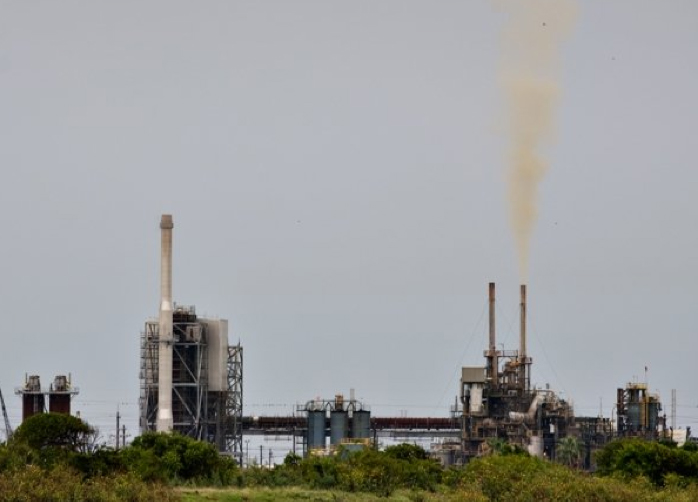 …is Gulf Chemical & Metallurgical Corporation, a "recycling" operation in Freeport on the coast where magma-spewing smokestacks are just business as usual. As chronicled by the Texas Observer's Forrest Wilder, it's also a case study on why the Texas Commission on Environmental Quality is an inadequate enforcer of the law. Not for the faint of heart or folks who think the government is already too tough on polluters.
…is Gulf Chemical & Metallurgical Corporation, a "recycling" operation in Freeport on the coast where magma-spewing smokestacks are just business as usual. As chronicled by the Texas Observer's Forrest Wilder, it's also a case study on why the Texas Commission on Environmental Quality is an inadequate enforcer of the law. Not for the faint of heart or folks who think the government is already too tough on polluters.
We Need Your Help on Wednesday
 Dallas is writing a new gas drilling ordinance. As part of this new set of rules, we have a chance to win the nation's first "off-sets" program for air pollution from gas drilling and processing.
Dallas is writing a new gas drilling ordinance. As part of this new set of rules, we have a chance to win the nation's first "off-sets" program for air pollution from gas drilling and processing.
Off-sets would require gas operators to pay for decreasing as much greenhouse gas air pollution as they're estimated to emit every year. If a company's annual air pollution emissions total 5 tons a year, it would have to fund projects that would reduce air pollution by 5 tons a year.
Every other major industrial source of air pollution in the DFW area is already subject to off-sets because of anti-smog regulations. Even though they can emit more air pollution than many of these industrial sources, a loophole allows gas operators to escape this requirement.
Greenhouse gases include smog-forming Nitrogen Oxide, CO2, and methane. Applying this program means Dallas would be the first local government in the country to require the gas industry off-sets. This would set a precedent and could be copied by other local governments in North Texas, just like Downwinders' Green Cement policies. And like those Green Cement policies, they could lead to significant air pollution reductions all over the region.
Off-sets help balance the costs of drilling by better reflecting its true impact. They act as an incentive to reduce pollution at the source. Together with larger buffer zones protecting homes and schools, and bans on drilling in parks and floodplains, off-sets can be part of a much tougher Dallas ordinance.
If off-sets are not required, new increases in gas industry emissions will continue to cancel out the kind of progress we've all worked so hard to achieve. As drilling has marched east, air monitors officially violating the old 85 parts per billion ozone standard have moved east as well. This year, we've already seen a monitor at I-35 and Mockingbird in inner city Dallas violate that standard – something it had not done since 2005.
We're now in the final stages of decision-making about the content of the Dallas ordinance. Beginning at 1 pm Wednesday at Dallas City Hall in Room 6ES, there's going to be a showdown of industry vs citizens.
Notorious gas industry PR spinmeister Ed Ireland will be speaking for 15 minutes about why Dallas needs to keep regulations loose. Attorney and Dallas gas drilling task force member Terry Welch will get 15 minutes to explain why the city needs to get tougher in its rules for drilling. Then the City Council will get to ask questions. No final decision for now, but the tone that's set at this "briefing session" will be critical.
Even if you don't live in Dallas, you have a stake in this decision. The pollution spewed by the gas industry in Dallas can become smog over Arlington, Ft. Worth, Denton, or Weatherford.
To be sure the Council members understand how important this issue is to Dallas' future and your present, we need you there at City Hall on Wednesday. Nothing says "concern" better than lots of people showing up to watch what happens. Likewise, empty seats are taken to mean there isn't much interest. It's during a workday, but if you can come, or send someone in your place, the effort will be worth it.
Videos and Pics of the DC Frack Attack Rally
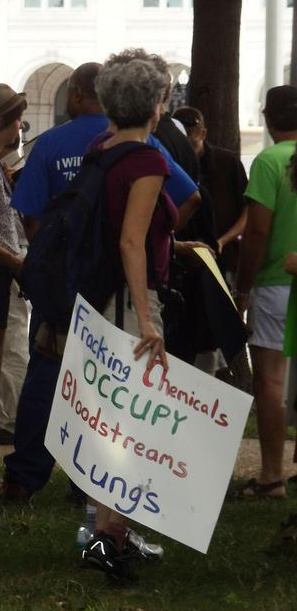 Via the Digital Journal, and Flickr here's a good sampling to give you a taste if you weren't there.
Via the Digital Journal, and Flickr here's a good sampling to give you a taste if you weren't there.
Think Nationally. Act Rationally. Stop the Frack Attack in Dallas
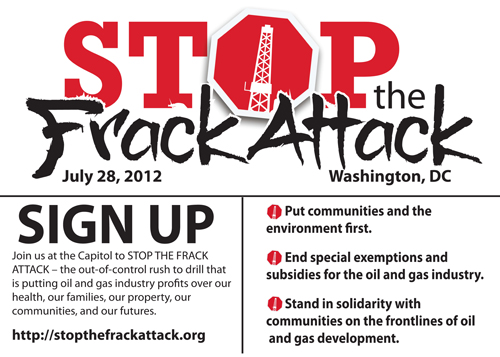 We want to extend a big ol' thank you to all those Barnett Shale residents who are in our nation's capital right now getting ready to attend the largest national rally on fracking ever held in the US.
We want to extend a big ol' thank you to all those Barnett Shale residents who are in our nation's capital right now getting ready to attend the largest national rally on fracking ever held in the US.
Former DISH Mayor Calvin Tillman, Earthworks' Sharon Wilson, former Decatur resident and gas victim Tim Ruggiero, are all among those up in Washington, giving interviews and raising constructive hell with the Texas Congressional delegation. Along with Don Young and CANDO, Gary Hogan and the folks at the North Central Texas Communities Alliance, and Susan Read in Grand Prairie, these are the most stalwart heroes of our local Shale fight.
Going on seven years now, they've been taking on the Oil and Gas industry in Texas (spend a moment thinking about what that means) on behalf of not only their own neighborhoods, but ours as well. And they started without all the evidence we have now about the hazards of fracking – known and unknown. All they had was their common sense and intuition.
And it was very lonely. For so long it was only the Barnett Shale that was in play. Only the middle of the country, in places where the nation's press wasn't headquartered, where celebs didn't have their summer homes, where, it seemed, nobody that could help them, cared about them.
Traditional environmental groups who they thought might side with them were instead being funded by their opponents because "natural gas was so much cleaner than coal." Non-traditional ones, like Downwinders we're sorry to say, were just not paying enough attention or had their own full agendas. So this first generation of fracking opponents had to start from scratch, with none of the resources, expertise, or support that just about any other environmental cause could expect to receive.
But they kept at it. And they built a huge library of real world knowledge about fracking. Not the theoretical PR clams, but what actually happens to people and land when the rigs show up. Their knowledge was so essential that a budding film maker named Josh Fox knew he had to make the Barnett Shale one of the stops to talk with them for his new film "Gasland." Their knowledge was going national just like the drilling.
Because as usually happens, greed got the better of an industry. The gas companies couldn't stop with the Barnett, or other rural western plays. They had to go east, to Pennsylvania, to New York, within hours of Manhattan. They began to imperial the summer homes, or water sources, or views, or health of very rich and powerful people who have access to more resources than your average angry DFW resident. Fracking got more media attention. It got more research attention in academia. It's becoming a part of popular culture. David Letterman is now ranting about fracking.
And tomorrow's rally in DC makes it official – fracking is now a national environmental controversy that's forcing citizens to build a national environmental movement. At the center of that movement, and somewhere in the center of that crowd tomorrow, stands those folks from the Barnett Shale who are finally seeing their cause get the kind of attention it deserves. It will be a banner day. Better late than never.
How can you help that movement if you're not in DC this week? By exploiting every opportunity to use what we now know about Fracking thanks to those early activists.
The largest city in the Barnett Shale is in the final stretch of writing a new gas drilling ordinance. This Wednesday at 1 pm on the 6th floor of Dallas City Hall, the City Council will be receiving its second briefing on the hazards of fracking. We need you there to show the Council you're interested in seeing a strong and protective ordinance. In Dallas, we have a chance to make progress in making the industry begin to pay for its own pollution, to set precedents that will be important. We can win. We can make things better. We can honor those whose work has given us a multitude of evidence of harm by using it to grab this Dallas ordinance by the horns and make the most out of it. Want to support the national anti-fracking movement? Think Nationally. Act Rationally in Dallas.

